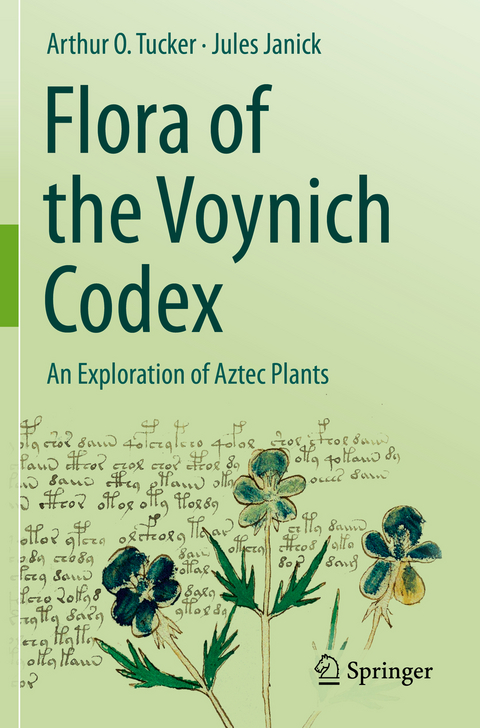
Flora of the Voynich Codex
Springer International Publishing (Verlag)
978-3-030-19379-9 (ISBN)
Despite the fact that this codex is largely an herbal, the interpreters of this manuscript with two exceptions, have not been botanists. To this end, our recent research suggests that the Voynich is a 16th century codex associated with indigenous Indians of Nueva España educated in schools established by the Spanish. This is a breakthrough in Voynich studies. We are convinced that the Voynich codex is a document produced by Aztec descendants that has been unfiltered through Spanish editors.
The flora of New Spain is vast, and the medicinal and culinary herbs used by the Aztecs were equally as copious. Even though it is our hypothesis that the Voynch Codex was written as a private herbal in 16th century New Spain, many of these herbs have relevance today because they or closely related species have been noted to be medicinal or have culinary value. The Voynich Codex has an estimated 359 illustration of plants (phytomorphs), 131 in the Herbal Section (large images) and 228 in the Pharmaceutical Section (small images of plant parts). In our book "Unraveling of the Voynich Codex", to be published by Springer this summer, Tucker and Janick have partially identified species in the Herbal Section. In this proposed work, all of the plants of the Herbal Section will be identified along with those plants of the Pharmacology Section where identification is feasible. Each plant identification will include subdivisions to include descriptors (formal botanical identification), names in English, Spanish, and Mesoamerican names where known, ecology and range, and properties (medicinal and culinary) of these and related species. Photographs of the phytomorphs and contemporary plants will be included. These identifications represent hard evidence that the Voynich Codex is a 16th Century Mexican manuscript. Exploring the herbs of the Aztecs through the Voynich Codex will be a seminal work for all Voynich researchers and also of interest to a wider audience in medicinal and culinary herbs, artists, and historians. In summary, our new book project Flora of the Voynich Codex will provide a photo-illustrated guide to complete the botanical evidence related to the Voynich Codex, one of the most valuable historic texts of the 16th century.lt;b>Dr. Arthur O Tucker, a plant taxonomist, is Professor Emeritus of Delaware State University and Founder and Co-Director Claude E. Phillips Herbarium (ca. 87th largest out of 525 herbaria in the U.S.). He is an expert in worldwide plant identification and the co-author of six books, including The Encyclopedia of Herbs (Timber Press). He has authored or co-authored 30 book chapters, 91 refereed scientific publications, and 169 popular publications. Tucker is the also coauthor of Unraveling the Voynich Codex published by Springer in 2018.
Dr. Jules Janick is the James Troop Distinguished Professor in the Department of Horticulture and Landscape Architecture at Purdue University. He is the Founder and Editor of Horticultural Reviews and Plant Breeding Review and has authored or edited over 150 volumes and has published widely on horticulture, genetics and breeding, horticultural history, art, and iconography Janick is the coauthor of Unraveling the Voynich Codex published by Springer in 2018.
Preface.- An Introduction to the Voynich Codex.- Aztec Botany, Agriculture, Trade, and Medicine.- Iconography and Phytomorphic Identification.- Phytomorph Identification in the Voynich Codex.- Aztec Plants in 16th Century New World and European Herbals.- Appendix A.- Appendix B.- Index.
"The Voynich Codex contains fantastical art with unusual symbols, bathing nymphs, zodiac signs, cosmological images, a kabbalah-like map, and illustrations of 21 animals and 358 plants. ... An appendix contains an extensive list of plants with their Nahuatl name and their identifications in the literature. ... Flora of the Voynich Codex is a comprehensive treatment of the botanical identification of plant images in the Voynich Codex." (Irwin Goldman, Chronica Horticulturae, Vol. 61 (4), 2021)
“The Voynich Codex contains fantastical art with unusual symbols, bathing nymphs, zodiac signs, cosmological images, a kabbalah-like map, and illustrations of 21 animals and 358 plants. … An appendix contains an extensive list of plants with their Nahuatl name and their identifications in the literature. … Flora of the Voynich Codex is a comprehensive treatment of the botanical identification of plant images in the Voynich Codex.” (Irwin Goldman, Chronica Horticulturae, Vol. 61 (4), 2021)
| Erscheinungsdatum | 26.09.2020 |
|---|---|
| Zusatzinfo | XIV, 353 p. 234 illus., 229 illus. in color. |
| Verlagsort | Cham |
| Sprache | englisch |
| Maße | 155 x 235 mm |
| Gewicht | 665 g |
| Themenwelt | Naturwissenschaften ► Biologie ► Botanik |
| Schlagworte | Ancient manuscript • Botany • cryptography • herbal • Lost language • Mesoamerica • systematic botany |
| ISBN-10 | 3-030-19379-9 / 3030193799 |
| ISBN-13 | 978-3-030-19379-9 / 9783030193799 |
| Zustand | Neuware |
| Haben Sie eine Frage zum Produkt? |
aus dem Bereich


